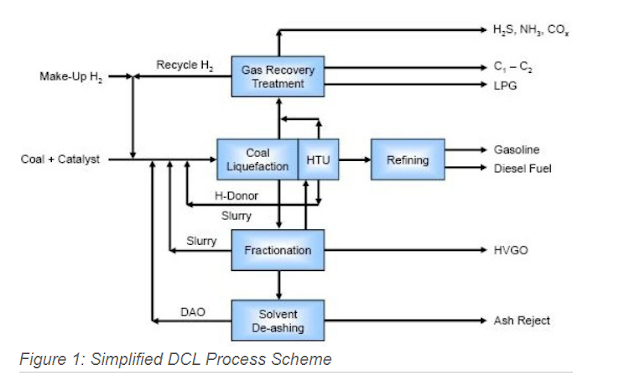Coal-to-oil by direct liquefaction is a process that bypasses gasification, which is a normal step in indirect coal liquefaction. The DOE’s NETL describes the process of direct coal liquefaction and compares it to indirect coal liquefaction as follows:
“Direct coal liquefaction involves contacting coal
directly with a catalyst {often cobalt iron-based} at elevated temperatures and
pressures with added hydrogen (H2), in the presence of a solvent to form a raw
liquid product which is further refined into product liquid fuels. DCL is
termed direct because the coal is transformed into liquid without first being
gasified to form syngas (which can then in turn be transformed into liquid
products). The latter two-step approach, i.e. the coal to syngas to liquids route
is termed indirect coal liquefaction (ICL). Therefore, the DCL process is, in
principle, the simpler and more efficient of the two processes. It does,
however, require an external source of H2, which may have to be provided by
gasifying additional coal feed, biomass and/or the heavy residue produced from
the DCL reactor. The DCL process results in a relatively wide hydrocarbon
product range consisting of a variety of molecular weights and forms, with
aromatics dominating. Accordingly, the product requires substantial upgrading
to yield acceptable transportation fuels.”
The world’s largest single
coal-to-liquids (CTL) project is located in the Ningdong Energy and Chemical
Industry Base, 40 km away from Yinchuan, the provincial capital of the Ningxia
Hui Autonomous Region, in the western part of China. Construction began in
2013, and it was commissioned in 2016. To convert 1 ton of oil, it consumes 3.5
tons of coal and 6.1 tons of water. China has a high demand for oil but a low
supply. They do, however, have a high supply of coal. Thus, the country has
long developed CTL technology. Liquifying coal results in double the CO
emissions relative to burning oil. It is, however, more readily captured.
According to Wikipedia, this project currently makes 4 million tons/year of
diesel & naphtha. The tables below show all the CTL projects in the world,
non-U.S. and U.S. Most of the U.S. projects have been cancelled as
uneconomical. The U.S. likely would be developing those projects if it hadn’t
been for the discovery and production of significant shale gas and oil reserves
over the past few decades.
The DCL technology DOE helped
to develop with Hydrocarbon Technologies, Inc., HTI (now part of Headwater,
Inc.), was licensed to Shenhua Corporation of China in 2002, which built a DCL
plant in Erdos, Inner Mongolia based on Headwaters technology. That first DCL
plant began operations in 2008. According to NETL:
“The DCL process involves adding hydrogen
(hydrogenation) to the coal, breaking down its organic structure into soluble
products. The reaction is carried out at elevated temperature and pressure
(e.g., 750 to 850°F and 1,000 to 2,500 psia) in the presence of a solvent. The
solvent is used to facilitate coal extraction and the addition of hydrogen. The
solubilized products, consisting mainly of aromatic compounds, then may be
upgraded by conventional petroleum refining techniques such as hydrotreating to
meet final liquid product specifications.”
China’s CTL capacity rose 24%
to 11 million tons in 2023 compared to 2019. A planned 4 million ton per day
CTL project expected to cost $24 billion is being developed by China Energy
Investment Corporation, formerly Shenhua, and is expected to begin operations
in 2027. This will be built in the Xinjiang region, which is rich in coal but
remote and far away from consumers. This would make up more than a quarter of
China’s current CTL capacity, but other CTL projects are in the works as well.
According to Global Times, the project is expected to produce 4 million tons of
CTL products annually, including 3.2 million tons from direct liquefaction and
800,000 tons from indirect liquefaction.
“The project combines coal mining, coal-to-oil
conversion, coal chemicals, renewable energy, and new materials production. It
features the world's first second-generation CTL technology and is the first
coal-to-oil project in Xinjiang.”
"The project taps into Hami's coal and renewable
energy resources to build a national coal-to-oil and gas strategic base,
boosting efficient coal use and strengthening Xinjiang region's role in China's
energy security," Lin Boqiang, director of the China Center for Energy
Economics Research at Xiamen University, told the Global Times on Wednesday.
It is uncertain whether
carbon capture will be a feature, but that seems a likely possibility as the
state-owned company operates CCS projects.
References:
China
Energy Investment readies $24bn for coal-to-oil project. Ed Pearsey. Offshore
Technology. October 10, 2024. China Energy Investment readies $24bn
for coal-to-oil project - Offshore Technology (offshore-technology.com)
Coal
liquefaction. Wikipedia. Coal liquefaction - Wikipedia
Direct
Liquefaction Processes. DOE. National Energy Technology Lab (NETL). 10.6. Direct Liquefaction Processes |
netl.doe.gov
Coal
Gasification and Liquefaction. Civils360. February 9, 2022. Coal Gasification and Liquefaction -
Explained | UPSC | Civils360 IAS
Visiting
the world’s biggest single coal-to-liquid project in Yinchuan, China. Xing
Zhang. June 27, 2017. IEA. Sustainable Carbon. Visiting
the world's biggest single coal-to-liquid project in Yinchuan, China - ICSC
China
Energy to invest $24 billion in coal-to-liquid project. October 10, 2024.
DieselNet. news: China
Energy to invest $24 billion in coal-to-liquid project
CHN
Energy Investment Group launches 170 billion yuan project in Xinjiang's Hami. Zhang
Yiyi. Global Times. October 9, 2024. CHN Energy
Investment Group launches 170 billion yuan project in Xinjiang's Hami - Global
Times





No comments:
Post a Comment